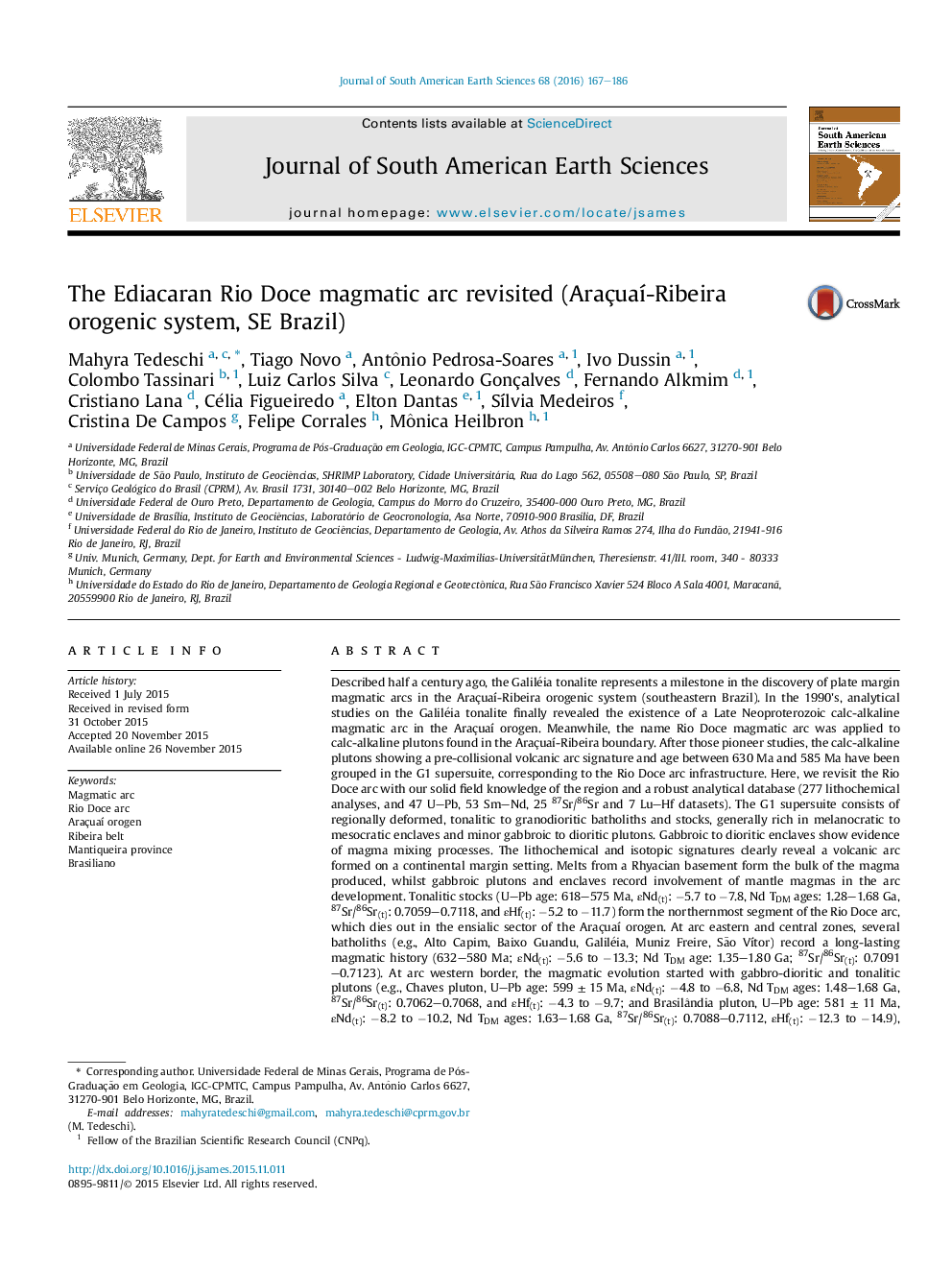| کد مقاله | کد نشریه | سال انتشار | مقاله انگلیسی | نسخه تمام متن |
|---|---|---|---|---|
| 4682041 | 1635142 | 2016 | 20 صفحه PDF | دانلود رایگان |

• Rio Doce arc revisited through a robust analytical database.
• Araçuaí and Ribeira: The Rio Doce connection.
• Lithochemistry and isotope signatures of the Rio Doce arc.
• Development of a magmatic arc from a gulf to an ocean: The Rio Doce arc.
Described half a century ago, the Galiléia tonalite represents a milestone in the discovery of plate margin magmatic arcs in the Araçuaí-Ribeira orogenic system (southeastern Brazil). In the 1990's, analytical studies on the Galiléia tonalite finally revealed the existence of a Late Neoproterozoic calc-alkaline magmatic arc in the Araçuaí orogen. Meanwhile, the name Rio Doce magmatic arc was applied to calc-alkaline plutons found in the Araçuaí-Ribeira boundary. After those pioneer studies, the calc-alkaline plutons showing a pre-collisional volcanic arc signature and age between 630 Ma and 585 Ma have been grouped in the G1 supersuite, corresponding to the Rio Doce arc infrastructure. Here, we revisit the Rio Doce arc with our solid field knowledge of the region and a robust analytical database (277 lithochemical analyses, and 47 U–Pb, 53 Sm–Nd, 25 87Sr/86Sr and 7 Lu–Hf datasets). The G1 supersuite consists of regionally deformed, tonalitic to granodioritic batholiths and stocks, generally rich in melanocratic to mesocratic enclaves and minor gabbroic to dioritic plutons. Gabbroic to dioritic enclaves show evidence of magma mixing processes. The lithochemical and isotopic signatures clearly reveal a volcanic arc formed on a continental margin setting. Melts from a Rhyacian basement form the bulk of the magma produced, whilst gabbroic plutons and enclaves record involvement of mantle magmas in the arc development. Tonalitic stocks (U–Pb age: 618–575 Ma, εNd(t): −5.7 to −7.8, Nd TDM ages: 1.28–1.68 Ga, 87Sr/86Sr(t): 0.7059–0.7118, and εHf(t): −5.2 to −11.7) form the northernmost segment of the Rio Doce arc, which dies out in the ensialic sector of the Araçuaí orogen. At arc eastern and central zones, several batholiths (e.g., Alto Capim, Baixo Guandu, Galiléia, Muniz Freire, São Vítor) record a long-lasting magmatic history (632–580 Ma; εNd(t): −5.6 to −13.3; Nd TDM age: 1.35–1.80 Ga; 87Sr/86Sr(t): 0.7091–0.7123). At arc western border, the magmatic evolution started with gabbro-dioritic and tonalitic plutons (e.g., Chaves pluton, U–Pb age: 599 ± 15 Ma, εNd(t): −4.8 to −6.8, Nd TDM ages: 1.48–1.68 Ga, 87Sr/86Sr(t): 0.7062–0.7068, and εHf(t): −4.3 to −9.7; and Brasilândia pluton, U–Pb age: 581 ± 11 Ma, εNd(t): −8.2 to −10.2, Nd TDM ages: 1.63–1.68 Ga, 87Sr/86Sr(t): 0.7088–0.7112, εHf(t): −12.3 to −14.9), followed by late granodioritic intrusions (e.g., Guarataia pluton, U–Pb age: 576 ± 9 Ma, εNd(t): −12.52 to −13.11, Nd TDM age: 1.74–2.06 Ga, 87Sr/86Sr(t): 0.7104–0.7110, εHf(t): −12.9 to −21.6). The Muriaé batholith (U–Pb age: 620–592 Ma, εNd(t): −8.2 to −13.6, Nd TDM age: 1.41–1.88 Ga) and the Conceição da Boa Vista (586 ± 7 Ma) and Serra do Valentim (605 ± 8 Ma) stocks represent a segment of the Rio Doce arc correlated to the Serra da Bolívia and Marceleza complexes, making the link between the Araçuaí and Ribeira orogenic domains. We suggest three phases of arc development: i) eastward migration of arc front (632–605 Ma), ii) widespread magma production in the whole arc (605–585 Ma), and iii) late plutonism in the western arc region (585–575 Ma). Usual processes of volcanic arc development, like subduction of oceanic lithosphere under a continental margin, followed by asthenosphere ascent related to slab retreating and break-off may explain the Rio Doce arc evolution.
Figure optionsDownload as PowerPoint slide
Journal: Journal of South American Earth Sciences - Volume 68, July 2016, Pages 167–186